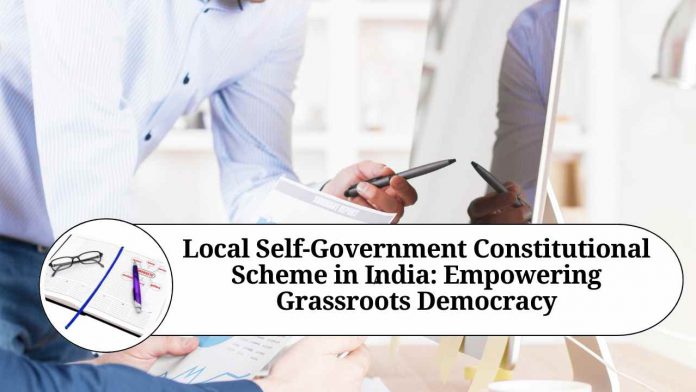Introduction
Local self-government plays a crucial role in empowering citizens and fostering grassroots democracy. In India, the constitutional scheme of local self-government provides a framework for decentralization and participatory governance. Enshrined in the 73rd and 74th Amendments to the Indian Constitution, the local self-government system has been instrumental in promoting inclusive development, empowering marginalized communities, and strengthening the democratic fabric of the nation. In this blog, we will explore the key features, significance, and challenges of the local self-government constitutional scheme in India.
Key Features of Local Self-Government in India
- Panchayati Raj Institutions (PRIs): The 73rd Amendment Act, 1992, introduced the concept of PRIs, which are local self-government bodies at the village, intermediate (block), and district levels. PRIs consist of elected representatives who form gram panchayats, panchayat samitis, and zilla parishads, respectively.
- Municipalities: The 74th Amendment Act, 1992, brought about a similar system for urban areas, establishing municipalities as local self-government bodies. Municipal corporations, municipal councils, and nagar panchayats are the three tiers of urban local governance.
- Constitutional Recognition: The amendments added the 11th and 12th Schedules to the Indian Constitution, which outline the functional domains of PRIs and municipalities. They include subjects such as agriculture, health, education, water supply, urban planning, and more.
- Direct Elections: The constitutional scheme mandates direct elections to PRIs and municipalities, ensuring democratic representation at the local level. Reservation of seats for Scheduled Castes (SCs), Scheduled Tribes (STs), and women further promotes social inclusion.
Significance of Local Self-Government
- Grassroots Democracy: The local self-government system empowers citizens by giving them the opportunity to participate directly in decision-making processes. It strengthens democratic values and fosters a culture of citizen engagement at the grassroots level.
- Inclusive Development: Local self-government brings governance closer to the people, enabling better identification and understanding of local needs. By involving local communities in decision-making, it facilitates targeted development initiatives and ensures inclusive growth.
- Empowering Marginalized Communities: Reserved seats for SCs, STs, and women in local self-government institutions aim to uplift historically marginalized sections of society. These provisions encourage equal representation and provide a platform for marginalized communities to voice their concerns and shape policies.
- Efficient Service Delivery: Local self-government bodies are responsible for delivering various public services, such as education, healthcare, water supply, sanitation, and infrastructure development. By decentralizing governance, the system aims to improve the efficiency and responsiveness of service delivery.
Challenges and the Way Forward
While the local self-government system in India has made significant strides, several challenges persist:
- Financial Autonomy: Many local self-government bodies struggle with inadequate financial resources. Enhancing their financial autonomy and devolving funds from higher levels of government is crucial for effective functioning and sustainable development.
- Capacity Building: Strengthening the capacity of elected representatives and local officials is essential to ensure effective governance. Training programs, knowledge-sharing platforms, and technical support can help build the necessary skills and capabilities.
- Women’s Empowerment: Despite reservation policies, women’s participation in local self-government remains limited. Efforts should be made to encourage women’s active involvement, including awareness campaigns, capacity-building initiatives, and removing socio-cultural barriers.
- Inter-Governmental Cooperation: Effective coordination between local self-government bodies, state governments, and central agencies is vital for successful implementation of policies and programs. Strengthening inter-governmental cooperation mechanisms can streamline governance processes.
Conclusion
The constitutional scheme of local self-government in India has provided a solid foundation for decentralization and participatory democracy. By empowering citizens, promoting inclusive development, and ensuring efficient service delivery, the system has played a pivotal role in transforming governance at the grassroots level. While challenges remain, sustained efforts to address financial, capacity-building, and gender-related issues will further strengthen the local self-government system and deepen democracy in India. It is through the active engagement and participation of citizens at the local level that a truly vibrant and inclusive democracy can thrive.
Read more useful content:
Frequently Asked Questions (FAQs)
Q.What is the purpose of the local self-government system in India?
The local self-government system aims to decentralize governance, empower citizens, and promote participatory democracy by bringing decision-making closer to the people at the grassroots level.
Q.What are Panchayati Raj Institutions (PRIs)?
Panchayati Raj Institutions are local self-government bodies in India established at the village, block (intermediate), and district levels. They comprise elected representatives who govern and administer local affairs.
Q.How are urban areas governed under the local self-government system?
Urban areas in India are governed through municipalities, which are local self-government bodies. Municipal corporations, municipal councils, and nagar panchayats are the three tiers of urban local governance.
Q.What subjects fall under the purview of local self-government institutions?
The 11th and 12th Schedules of the Indian Constitution outline the functional domains of PRIs and municipalities, respectively. These schedules include subjects such as agriculture, health, education, water supply, urban planning, and more.
Q.How are representatives in local self-government institutions elected?
Representatives in local self-government institutions are elected through direct elections. This ensures democratic representation and allows citizens to choose their local leaders.
Q.What is the significance of reserved seats for marginalized communities?
Reserved seats for Scheduled Castes (SCs), Scheduled Tribes (STs), and women in local self-government institutions promote social inclusion and empower historically marginalized sections of society, ensuring their representation in decision-making processes.
Q.How does the local self-government system contribute to inclusive development?
The system brings governance closer to the people, allowing for better identification of local needs and targeted development initiatives. By involving local communities in decision-making, it promotes inclusive growth and ensures that development efforts address the specific challenges faced by different regions.
Q.What are the challenges faced by local self-government institutions in India?
Some challenges include inadequate financial resources, capacity-building needs of elected representatives and officials, limited women’s participation, and the need for enhanced inter-governmental cooperation for effective implementation of policies and programs.
Q.How can financial autonomy be improved for local self-government bodies?
Enhancing financial autonomy can be achieved by devolving more funds from higher levels of government, implementing revenue-generation measures at the local level, and exploring innovative financing models such as public-private partnerships.
Q.How can citizens actively engage with local self-government institutions?
Citizens can engage with local self-government institutions by participating in meetings, providing inputs and feedback on policies and programs, joining local committees or groups, and volunteering in community development initiatives. They can also utilize information channels, such as official websites and social media platforms, to stay informed and voice their concerns.




















